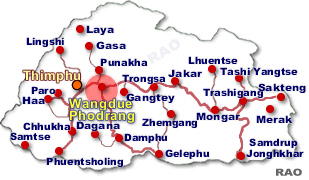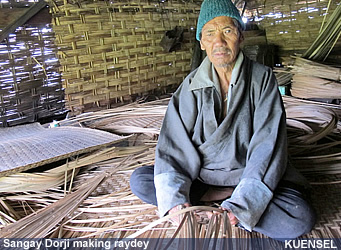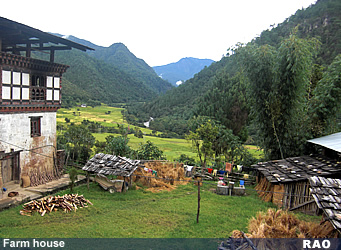 |
Bhutan's
Economy |
|
 |
Bhutan Information |
|
|
 |
| Bamboo weaving on the wane |
 |
 |
|
Sephu Gewog: The once thriving bamboo weaving tradition in Sephu gewog is under threat, not only from raw materials drying up, but also from the younger generation, who prefer collecting cordyceps, which they say is financially more rewarding.
The immediate issue though is the dying bamboo tufts planted in the gewog, which have left veteran weavers like Sangay Dorji, 73, wondering what to do by next year.
|
|
 |
|
Sangay Dorji, who has three stepchildren, is worried his cash income from sale of bamboo woven items like lubs (container to store grains) and tea strainers is about to dry up as well.
From Lhubsu village, about seven kilometres from Chazam on the Wangdue-Trongsa highway, the veteran weaver learned the craft from his late father when he was 10.
Within a few years, his products spread all over paddy growing villages in the dzongkhag. "Lub was in high demand," Sangay Dorji said.
|
|
Other items, which were in high demand were raydey, a carpet like mat to dry grains and changcho and phincha.He bartered those items for rice and food grains with farmers of Trongsa, Zhemgang, Punakha and rice growing villages in Wangdue. "Those days we grew only wheat, which was our staple," he said. The highlanders couldn't grow rice because of the cold.
A study shows that bamboo dies after hundred years
Last year he earned around Nu 40,000 selling bamboo items.But he does not see a fruitful journey ahead.
 |
|
Sangay expects his income to drop dramatically next year.What he has been making this year is from his stock of bamboo that needs to be cut and dried for a year, before it is shaped into products. "We keep it beneath the roof to protect from frost and rain," Sangay Dorji said.
A couple of years ago, bamboo items would be seen in shops at Chazam and Rukubji along Wangdue and Trongsa highway.Not anymore.
A study by forestry officials found that the bamboo, locally known as chuba, dies after every hundred years. "It dies when it flowers," ranger Sangay Penjor said.
|
|
"The flowering period lasts two to three years."
A senior forest officer, Chencho Wangdi in Wangdue range office, said bamboo found in Sephu is of the dendrocalamus species.It grows about 2 to 3 feet tall in a year, and grows 5 to 6 feet if it is cut and planted.
But the bigger threat to Sephu's bamboo tradition is the young people in the gewog taking to picking the magical fungus, instead of learning to weave the bamboo.
Dawa Tshering, 34, from Lambji village gave up bamboo weaving after the government legalised fungi collection.He used to make Nu 25,000 a year, but now he earns Nu 150,000 a year from the fungi business. "The difference is like the sky and the earth," he said.
"Until five years there were around 50 bamboo weavers, now we have only a few," Sephu gup, Rinchen Penjor, said.The gewog's more than 300 households are all into the fungi that has cast a dark shadow on bamboo weaving.
| Contributed
by Tenzin Namgyel,KUENSEL, Bhutan's National Newspaper, 2012 |
 |
| Information on Bhutan |
 |
|





